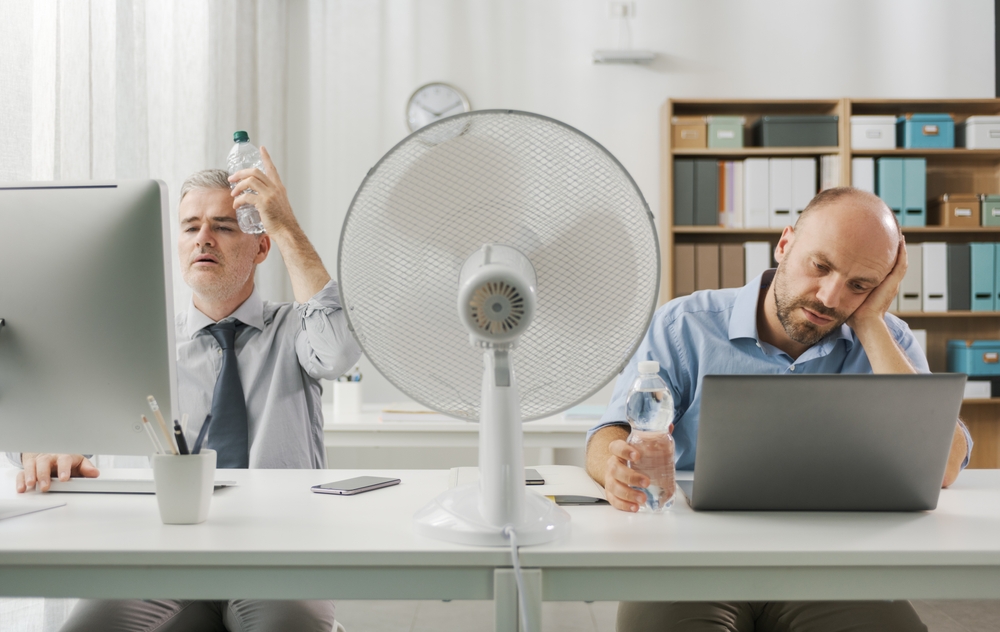We recently published a guide to managing extreme temperatures in the workplace. This guide outlined the risks that extreme temperatures can pose to your staff and your business and offered some tips on how you can help everyone keep cool.
In this post we’ll explore what your legal responsibilities are when it comes to extreme workplace temperatures.
If you want to understand and manage the specific risks you face in your business, we have a team of friendly experts on hand to help who can advise on your risk management and insurance needs. Contact us on 020 8290 9080 or email business@anthonyjones.com.
Do Businesses Have a Legal Duty to Keep Your Staff Cool?
All workplaces are different. Some will be exposed to high temperatures as a matter of course. For this reason, there is no law defining the maximum working temperature. There is no point at which it is legally too hot to work.
However, you do have a duty of care to your staff, and HSE highlights that this extends to ensuring their “thermal comfort”.
What is Thermal Comfort?
When HSE refers to “thermal comfort”, they’re essentially talking about the factors that make for a comfortable workplace temperature. These will vary from workplace to workplace, and from one employee to another.
HSE stresses that it’s not necessarily the high temperatures themselves that carry a risk. If people are too hot – or too cold – then they may behave in such a way that would make errors more likely:
- They may struggle to focus, and their reaction speeds may slow. Not only will this make your business less productive, but it could also lead to costly errors and even increase the risk of accidents and injury.
- Workers may choose not to wear certain PPE and other safety equipment if the temperature’s too high. This will compromise their safety, and it could even have business insurance implications.
- Workers may take short cuts to spend as little time as possible in environments that are too hot, or too cold. Again, this could lead to mistakes, accidents, and injuries.
HSE outlines that, as an employer, “you should be aware of these risks and make sure the underlying reasons for these unsafe behaviours are understood and actively discouraged and prevented.”
Read the full HSE guidance on thermal comfort.
What’s the Ideal Workplace Temperature?
Recommended Minimum Workplace Temperatures
Although there are no recommendations for maximum temperatures, HSE does offer some guidelines on the sort of temperatures you should aim for in the workplace. At least, they specify what the minimum temperature should be: 16°C, or 13°C if the work involves a lot of physical effort.
Maximum Workplace Temperature Guidelines
In terms of the maximum temperature, HSE offers the following guidelines:
- The temperature should provide “reasonable comfort without the need for special clothing.” If this is not possible due to the specific nature of the work, then you should take “all necessary steps” to “achieve a temperature which is as close as possible to comfortable.”
- If the temperature in the workspace is “uncomfortably high”, then you must “take all reasonable steps to achieve a reasonably comfortable temperature”. Among other things, HSE recommends insulating pipes, shading windows, and providing fans and other local cooling systems.
- You should provide thermometers throughout the workplace so that staff can monitor the temperature, and take appropriate action if it gets too high, or too low. These thermometers should not be placed near windows, or near any sources of heat.
You can read these HSE guidelines in full (see Regulation 7, paragraphs 60 – 69).
Take Your Duty of Care Seriously
There is no legal maximum temperature for the workplace. However, if you’re aware of the risks that can arise from excessive temperatures, then you have a duty of care to take steps to mitigate these risks.
If your staff are too hot, their productivity will suffer, and they may be more likely to make mistakes. These mistakes could, in turn, lead to costly losses, and potentially to accidents and injuries. And if an employee injures themselves or others on the job, then you certainly could face some legal action.
The British Safety Council has some good advice for helping your staff keep cool during heatwaves. You can also read our guide to heatwaves and extreme temperatures in the workplace.
If you want to understand and manage the specific risks you face in your business, we have a team of friendly experts on hand to help who can advise on your risk management and insurance needs. Contact us on 020 8290 9080 or email business@anthonyjones.com.


